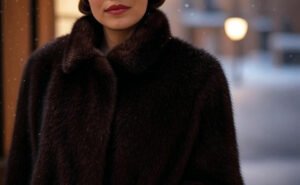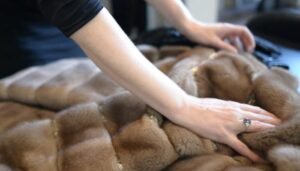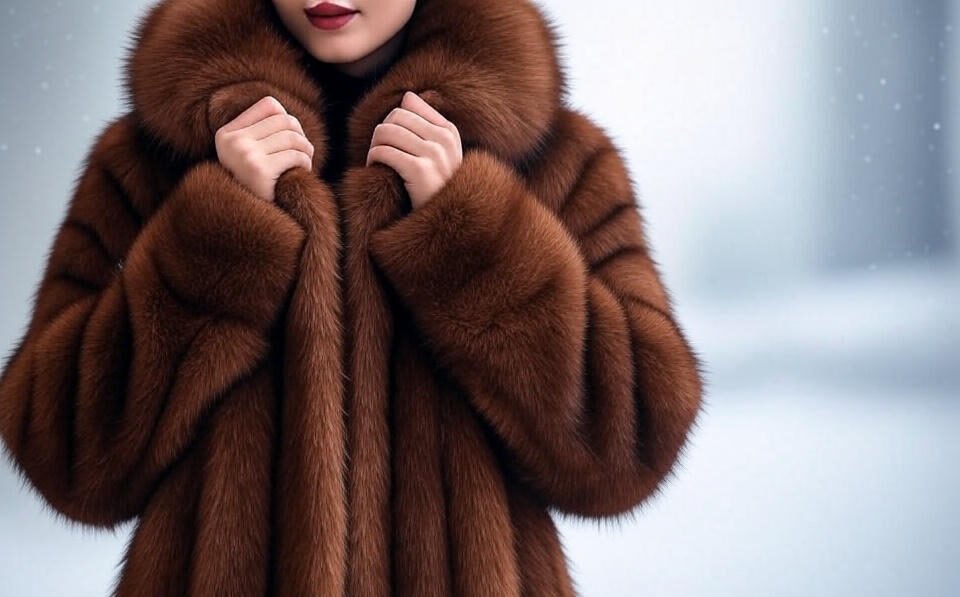Mink coats capture attention with their elegance and warmth, making them a favorite in cold-weather fashion. Many people wonder what goes into creating these luxurious garments. We explores the origins of mink fur, the production process, and other key details. By the end, you’ll understand everything about mink coats and what makes them special.
Understanding Mink Fur
Mink fur forms the heart of these coats, prized for its softness and durability. The fur comes from a specific animal raised carefully to produce high-quality pelts.
The Mink Animal
Minks belong to the weasel family, known for their slender bodies and short legs. These small mammals grow to about two feet in length and weigh around two pounds. Farmers raise most minks on specialized farms, though wild minks exist in North America and Europe. Farms dominate the fur supply due to controlled breeding and care. Minks eat a diet of meat and fish, which helps their fur develop a thick, healthy texture. Farmers monitor the animals until they reach maturity, usually within a year, when their pelts are ready for harvest.
Characteristics of Mink Fur
Mink fur stands out for its soft, dense texture. It consists of short underfur that traps heat effectively and longer guard hairs that add a glossy finish. This combination makes mink coats warm yet lightweight. The fur naturally shines, giving it a polished look that appeals to fashion lovers. Mink fur resists wear and stays supple with proper care, making it a long-lasting choice. Unlike heavier furs, mink feels comfortable even during extended wear, which adds to its popularity.
Variations in Mink Fur
Mink fur comes in several natural shades, with dark brown being the most common. Black mink offers a rich, deep color, while white mink appears rare and striking. Breeders also produce unique shades like mahogany or pearl through selective breeding. Male mink pelts tend to be thicker and larger, ideal for fuller coats. Female pelts feel lighter and silkier, often used for sleeker designs. These variations allow designers to create coats for different styles and preferences.
The History of Mink Coats

Mink coats carry a rich history in fashion. Fur has long served as a source of warmth, dating back to ancient times when people wore animal skins to survive harsh winters. By the 19th century, mink fur became a symbol of wealth and status, favored by royalty and the elite. The 1920s marked the rise of mink farming, which made these coats more accessible to a broader audience. During the mid-20th century, mink coats reached peak popularity, worn by celebrities and public figures. Iconic campaigns highlighted their glamour, cementing their place in fashion. Today, while ethical concerns influence opinions, mink coats remain a sought-after choice for their timeless appeal.
The Production Process of Mink Coats
Creating a mink coat involves a detailed process, starting with farming and ending with skilled craftsmanship. Each step requires care to ensure a high-quality final product.

Mink Farming
Farmers raise minks in controlled environments, housing them in pens with access to food and water. Breeding occurs in winter, with pups born in spring. Farmers provide a balanced diet to promote healthy fur growth. They monitor the animals’ health daily, giving vaccines and addressing any issues. Farms often operate in cooler climates, as minks thrive in these conditions. This careful management ensures the pelts meet the standards needed for luxury coats.
Harvesting and Processing Pelts
Harvesting happens in late fall when the mink’s fur reaches its prime. Workers use regulated methods to ensure the process follows ethical guidelines. After harvesting, they clean the pelts and remove excess tissue through a process called fleshing. Tanning follows, softening the leather side of the pelt to make it pliable. Some pelts get dyed to achieve vibrant colors like red or blue, while others are bleached for lighter shades. The processed pelts are then sold at auctions to coat manufacturers, who select the best ones for their designs.
Crafting the Coat
Designers choose pelts that match in color and texture to create a uniform look. They cut the pelts into precise shapes based on patterns, ensuring minimal waste. Skilled sewers stitch the pieces together, creating the coat’s structure. They add linings, often made of silk or satin, for comfort against the skin. Buttons, hooks, or zippers complete the design, and the coat undergoes thorough quality checks to ensure no flaws. The result is a beautifully crafted garment that feels smooth and fits perfectly.
Types of Mink Coats
Mink coats come in various styles to suit different tastes. Each type highlights specific qualities of the fur, offering options for every preference.
Natural Mink Coats
Natural mink coats retain the fur’s original color, typically brown or black. These coats appeal to those who prefer a classic, understated look. The untreated fur maintains its authentic texture and shine, making it a timeless choice. With proper care, natural mink coats last for decades, offering both style and durability.
Dyed Mink Coats
Dyed mink coats feature bold, customized colors like deep red, soft blue, or even pastel tones. The dyeing process preserves the fur’s softness while allowing designers to experiment with modern fashion trends. Dyed coats often hide minor imperfections in the pelts, making them a versatile option for unique, eye-catching styles.
Sheared and Let-Out Mink Coats
Sheared mink coats have their guard hairs trimmed to create a smooth, velvet-like texture. This gives the coat a sleek, modern appearance while keeping it warm. The let-out technique involves cutting pelts into thin strips and resewing them to create longer, more tailored coats. This method uses fewer pelts efficiently, resulting in a seamless, elegant design.
Ethical Considerations in Mink Farming
Mink farming sparks debate due to concerns about animal welfare. Critics argue that small cages cause stress for minks, leading to unnatural behaviors. Health risks, like disease outbreaks, also raise concerns, as seen during past incidents where illnesses spread among farmed minks. Farmers work to improve conditions by upgrading pens and enhancing care practices to meet stricter regulations. Some regions have banned mink farming, pushing the industry toward better standards. Buyers increasingly seek coats from farms with ethical practices, balancing fashion with responsibility.
Environmental impacts also matter. Farms consume significant water and feed resources, and waste can affect local ecosystems. However, the industry supports jobs in many communities, creating an economic balance. These factors encourage informed choices when purchasing mink coats.
Alternatives to Mink Coats
For those hesitant about real fur, alternatives offer warmth and style without animal products. Faux fur, made from synthetic fibers, closely mimics the look and feel of mink. It’s affordable and aligns with animal-free values. Wool coats, often blended with cashmere, provide excellent insulation and a soft touch. Down jackets, filled with feathers or plant-based materials, offer lightweight warmth ideal for travel. Eco-friendly coats made from recycled plastics appeal to environmentally conscious shoppers, reducing waste while keeping wearers cozy.
How to Care for Your Mink Coat
Proper care ensures a mink coat stays beautiful for years. Simple steps make a big difference in maintaining its quality.
Storage Tips
Store your mink coat in a fabulous, dark closet to prevent fading. Use a wide, padded hanger to maintain its shape. Avoid plastic bags, as they trap moisture and cause damage. In humid climates, consider professional storage during warmer months to protect the fur from heat and dampness.
Cleaning Methods
Take your coat to a fur specialist for cleaning once a year. They use gentle methods to remove dirt without harming the fur. At home, shake the coat lightly to remove dust. Avoid using water or household cleaners, as they can dry out the pelts. If the coat gets wet, hang it to air dry naturally, away from heat sources.
Conclusion
Mink coats, made from the fur of farmed minks, combine warmth, durability, and elegance. The production process, from raising animals to crafting the final garment, requires precision and skill. While mink coats have a storied place in fashion, ethical concerns and alternatives like faux fur or wool provide options for different preferences. With proper care, a mink coat can last for decades, making it a worthy investment. This guide equips you with the knowledge to understand and choose mink coats wisely.
FAQs
What animal provides fur for mink coats?
Minks, small mammals from the weasel family, supply the fur for these coats.
How are mink pelts processed?
Workers clean, tan, and sometimes dye the pelts before sewing them into coats.
Are there alternatives to mink coats?
Faux fur, wool, and down coats offer warmth without using real animal fur.
How do you clean a mink coat?
Please take it to a professional fur cleaner annually and avoid water or home cleaning methods.
For more article :https://quicktrends.co/








